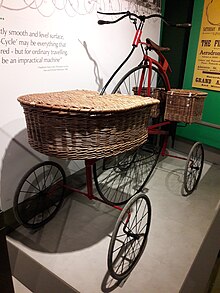
A pentacycle ("hen and chickens" ) is a human-powered five-wheeled vehicle.

A pentacycle ("hen and chickens" ) is a human-powered five-wheeled vehicle.
The original pentacycle was designed and patented by the architect Edward Burstow in 1882. [1] [2] It had a large central wheel directly driven by pedals like a penny farthing bicycle, with a "bath-chair type handle", and four smaller wheels for stability. [2] This arrangement led to it being referred to as the "hen and chickens" cycle, as it resembled a mother hen surrounded by her four chicks. It was trialled by rural postmen in Horsham and, although liked, the design was not widely adopted. [1] There is a replica in the British Postal Museum. [3]
Modern day pentacycles do not often share the same layout as the original pentacycle, usually using various other wheel configurations.
A 2002 interpretation, specifically designed to use the disused Aérotrain monorail track near Orléans, is more accurately described as a tricycle; although it has five wheels, two are actually used for guidance and are placed on either side of the monorail support. [4] [ better source needed ]
In 2012 Sajjad Moosa, a Pakistani art graduate, spent almost ₹150,000 (US$1,900) creating a 48 foot (15 m) long pentacycle using a single front wheel for steering, a middle pair of wheels for drive and another pair at the rear. [5]

A recumbent bicycle is a bicycle that places the rider in a laid-back reclining position. Most recumbent riders choose this type of design for ergonomic reasons: the rider's weight is distributed comfortably over a larger area, supported by back and buttocks. On a traditional upright bicycle, the body weight rests entirely on a small portion of the sitting bones, the feet, and the hands.
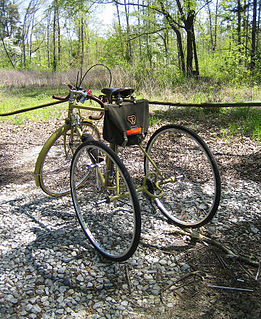
A tricycle, sometimes abbreviated to trike, is a human-powered three-wheeled vehicle.

The penny-farthing, also known as a high wheel, high wheeler or ordinary, was an early type of bicycle. It was popular in the 1870s and 1880s, with its large front wheel providing high speeds and comfort.

A velomobile ; velomobiel, velo, or bicycle car is a human-powered vehicle (HPV) enclosed for aerodynamic advantage and/or protection from weather and collisions. Velomobiles are similar to recumbent bicycles, pedal go-karts and tricycles, but with a full fairing and are not to be confused with purpose-built mobiles for racing or speed records fully faired vehicles with two wheels, generally called streamliners. Streamliners have set many speed and distance records.

Pashley Cycles is a British bicycle, tricycle and workbike manufacturer based in Stratford-upon-Avon in Warwickshire, England. The company was started in 1926 and still manufactures bikes in the UK.

A cargo bike is a human powered vehicle designed and constructed specifically for transporting loads. Cargo bike designs include a cargo area consisting of an open or enclosed box, a flat platform, or a wire basket, usually mounted over one or both wheels, low behind the front wheel, or between parallel wheels at either the front or rear of the vehicle. The frame and drivetrain must be constructed to handle loads larger than those on an ordinary bicycle.
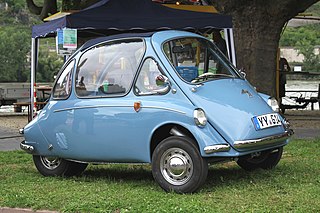
Microcar is a term often used for the smallest size of cars, with three or four wheels and often an engine smaller than 700 cc (43 cu in). Specific types of microcars include bubble cars, cycle cars, invacar, quadricycles and voiturettes. Microcars are often covered by separate regulations to normal cars, having relaxed requirements for registration and licensing.
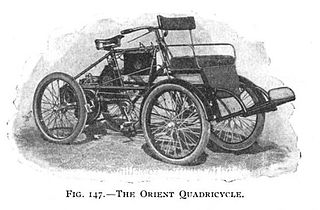
Quadricycle refers to vehicles with four wheels.

A velocipede is a human-powered land vehicle with one or more wheels. The most common type of velocipede today is the bicycle.

Vehicles that have two wheels and require balancing by the rider date back to the early 19th century. The first means of transport making use of two wheels arranged consecutively, and thus the archetype of the bicycle, was the German draisine dating back to 1817. The term bicycle was coined in France in the 1860s, and the descriptive title "penny farthing", used to describe an "ordinary bicycle", is a 19th-century term.
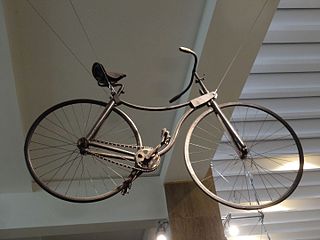
A safety bicycle is a type of bicycle that became very popular beginning in the late 1880s as an alternative to the penny-farthing ("ordinary") and is now the most common type of bicycle. Early bicycles of this style were known as safety bicycles because they were noted for, and marketed as, being safer than the high wheelers they were replacing. Even though modern bicycles use a similar design, the term is rarely used today and is considered obsolete outside circles familiar with high wheelers.

A tilting three-wheeler, tilting trike, leaning trike, or even just tilter, is a three-wheeled vehicle and usually a narrow-track vehicle whose body and or wheels tilt in the direction of a turn. Such vehicles can corner without rolling over despite having a narrow axle track because they can balance some or all of the roll moment caused by centripetal acceleration with an opposite roll moment caused by gravity, as bicycles and motorcycles do. This also reduces the lateral acceleration experienced by the rider, which some find more comfortable than the alternative. The narrow profile can result in reduced aerodynamic drag and increased fuel efficiency. These types of vehicles have also been described as "man-wide vehicles" (MWV).

A motorized bicycle is a bicycle with an attached motor or engine and transmission used either to power the vehicle unassisted, or to assist with pedalling. Since it sometimes retains both pedals and a discrete connected drive for rider-powered propulsion, the motorized bicycle is in technical terms a true bicycle, albeit a power-assisted one. Typically they are incapable of speeds above 52 km/h (32 mph).

A steam tricycle is a steam-driven three-wheeled vehicle.
The term monorail or industrial monorail is used to describe any number of transport systems in which a chair or carrier is suspended from, or rides on, an overhead rail structure. Unlike the well-known duo-rail system, there are many rail-guided transport options which have been described as monorails, so that tracing the history presents a demarcation problem regarding what should be included and what should be omitted.

A handcycle is a type of human-powered land vehicle powered by the arms rather than the legs, as on a bicycle. Most handcycles are tricycle in form, with two coasting rear wheels and one steerable powered front wheel. Despite usually having three wheels, they are also known as handbikes.

A rowing cycle is a wheeled vehicle propelled by a rowing motion of the body. Steering, braking, and shifting are usually done by the handlebars. Feet are on symmetrical foot rests, as opposed to rotating pedals. Unlike many rowing boats, the rider faces forward. Rowing cycles exist in numerous designs, particularly with respect to frames and drive mechanisms. Commercial production numbers for rowing cycles are small compared to that of standard bicycles.

A quadracycle is a four-wheeled human-powered land vehicle. It is also referred to as a quadricycle, quadcycle, pedal car or four-wheeled bicycle amongst other terms.
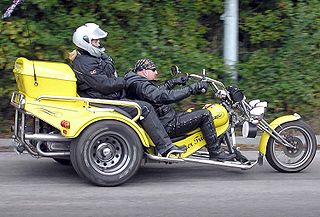
A motorized tricycle, motor trike, or motortrycle is a three-wheeled vehicle based on the same technology as a bicycle or motorcycle, and powered by an electric motor, motorcycle, scooter or car engine.

Invalid carriages were usually single seater road vehicles, buggies, or self-propelled vehicles for disabled people. They pre-dated the electric mobility scooters and from the 1920s were generally powered by a small gasoline/petrol engine, although some were battery powered. They were usually designed without foot-operated controls.